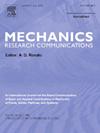Recent developments in the modeling of thin-walled structures combining GBT and shell finite elements
IF 2.3
4区 工程技术
Q3 MECHANICS
引用次数: 0
Abstract
This paper presents a state-of-the art report on recent developments concerning the modeling of thin-walled members and frames, by combining the advantages of Generalized Beam Theory (GBT) and conventional shell finite elements. Two approaches are reported. The first one combines, in the same model, GBT-based (beam) and shell finite elements, through appropriate constraint equations. The beam elements are employed only in the elastic and prismatic zones, since the remaining zones are handled more efficiently with shell elements. The second approach recovers the insightful GBT mode participations from shell finite element results, through post-processing operations. This approach is useful when GBT elements are not available, cannot be employed (e.g., in tapered members) or are not computationally advantageous, and has a significant potential of application in standard finite element programs, since its implementation is quite straightforward. Throughout the paper, several numerical examples are presented and discussed, to illustrate the application and show the capabilities of the two approaches.
GBT与壳单元结合薄壁结构建模的最新进展
本文结合广义梁理论(GBT)和传统壳有限元的优点,介绍了薄壁构件和框架建模的最新进展。报告了两种方法。第一种是在同一模型中,通过适当的约束方程,将基于gbt的(梁)有限元和壳有限元结合起来。梁单元仅用于弹性和棱柱区域,因为其余区域使用壳单元更有效地处理。第二种方法通过后处理操作从壳有限元结果中恢复有洞察力的GBT模式参与。当GBT单元不可用,不能使用(例如,在锥形构件中)或计算上不有利时,这种方法很有用,并且在标准有限元程序中具有重要的应用潜力,因为它的实现非常简单。在整篇文章中,给出并讨论了几个数值例子,以说明这两种方法的应用和能力。
本文章由计算机程序翻译,如有差异,请以英文原文为准。
求助全文
约1分钟内获得全文
求助全文
来源期刊
CiteScore
4.10
自引率
4.20%
发文量
114
审稿时长
9 months
期刊介绍:
Mechanics Research Communications publishes, as rapidly as possible, peer-reviewed manuscripts of high standards but restricted length. It aims to provide:
• a fast means of communication
• an exchange of ideas among workers in mechanics
• an effective method of bringing new results quickly to the public
• an informal vehicle for the discussion
• of ideas that may still be in the formative stages
The field of Mechanics will be understood to encompass the behavior of continua, fluids, solids, particles and their mixtures. Submissions must contain a strong, novel contribution to the field of mechanics, and ideally should be focused on current issues in the field involving theoretical, experimental and/or applied research, preferably within the broad expertise encompassed by the Board of Associate Editors. Deviations from these areas should be discussed in advance with the Editor-in-Chief.

 求助内容:
求助内容: 应助结果提醒方式:
应助结果提醒方式:


